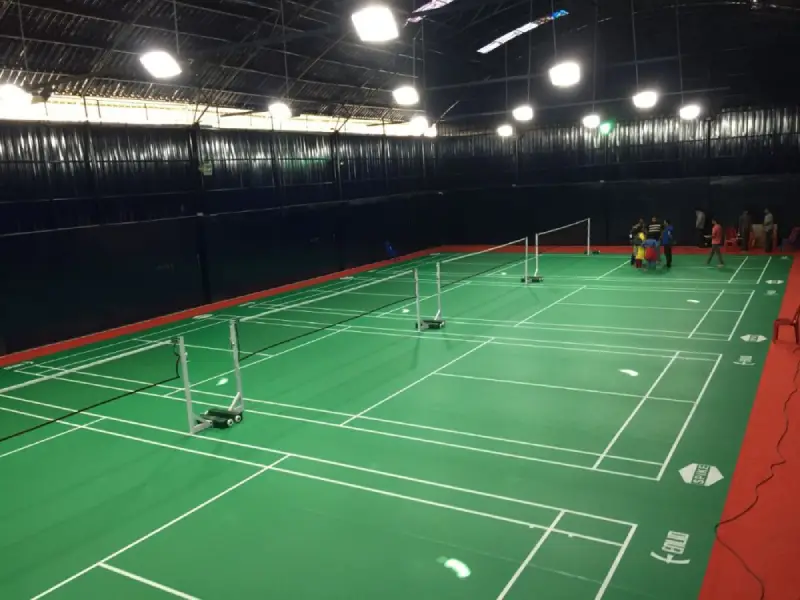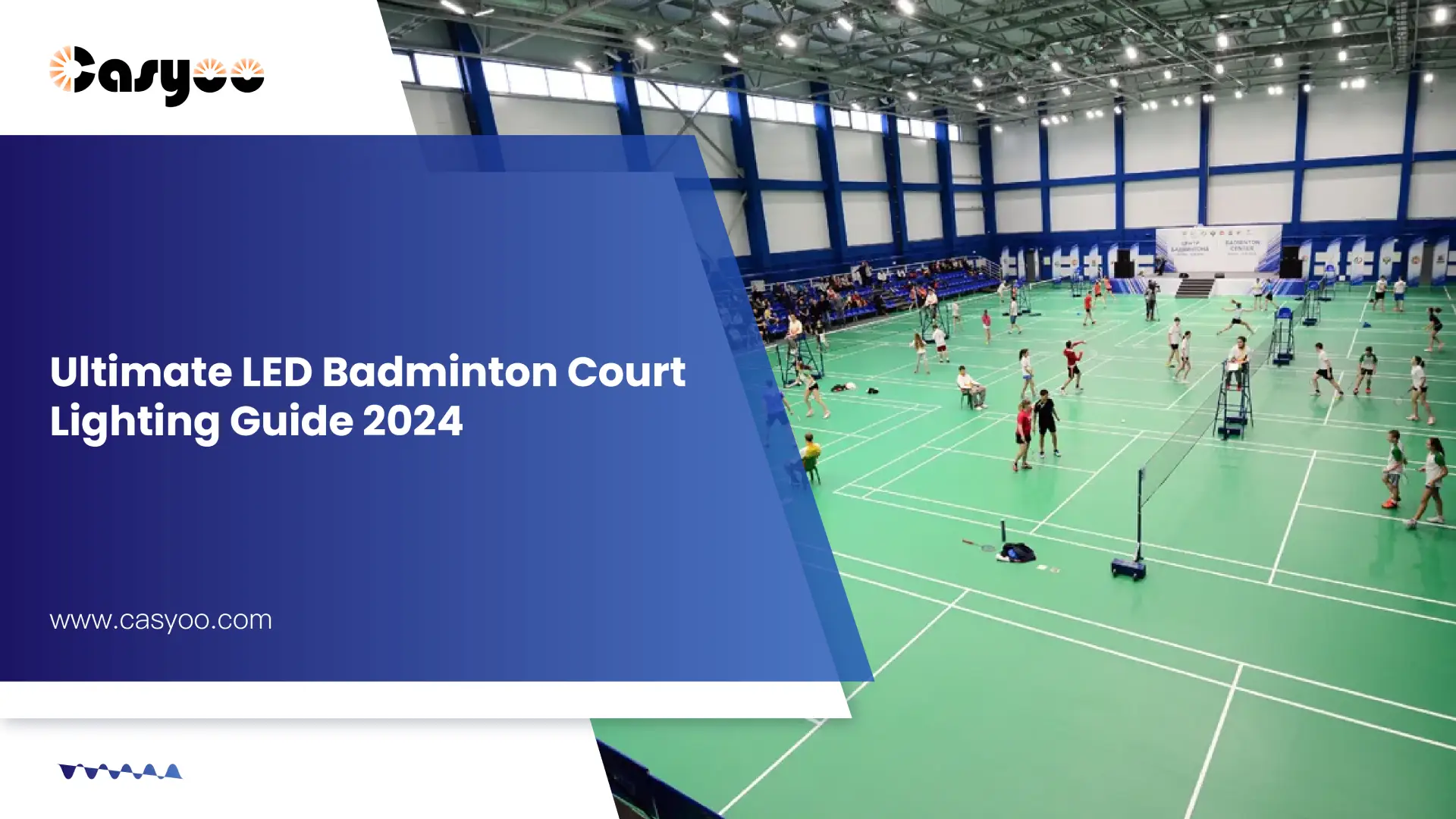More than most players realize, improper LED badminton court lighting has an impact on games. Actually, a lot of players have trouble with delayed reactions and missed shots. Even though they deal with these issues on a daily basis, they hardly ever attribute the problem to poor illumination. I have years of experience as an LED sports lighting engineer, and I have seen firsthand how good lighting improves player performance and the overall quality of games. Therefore, modernizing its lighting is among the best expenditures any organization can make.
Lighting an LED badminton court effectively involves more than simply brightness. Additionally, players must follow swift shuttlecocks along their whole flight path. We now have unheard-of control over every facet of LED badminton court lighting because of contemporary LED technology, which has completely changed how we approach this problem.
Understanding Badminton Court Lighting Standards
Required Illuminance Levels
Accurate lighting conditions are essential for professional badminton courts. Both broadcasting requirements and competitive play must be satisfied by these standards. Three different classes of illumination are specified by international regulations, depending on the degree of play. For example, Class II facilities require 1000 lux of horizontal illumination, while Class I venues must have at least 2000 lux. Recreational courts, meanwhile, ought to keep at least 500 lux.
Player safety and performance are greatly impacted by these criteria. Our field testing in several locations have led us to an intriguing discovery. Compared to Class III illumination, players miss fewer shots in Class I lighting. Better depth perception and quicker reaction times made possible by adequate lighting are the causes of this improvement.
The standards also take broadcast and spectator requirements into account. For high-speed cameras, class I illumination is crucial. After all, for slow-motion replays, these cameras frequently need to record at 120 frames per second or more. Furthermore, the flickering effect that is frequently observed with slower shutter speeds in low light conditions is avoided by the greater illuminance levels.
Total Lumens Requirements
The average total lumen need for professional courts is between 200,000 and 400,000. The precise specifications, however, differ depending on the court’s size and mounting height. Light efficiency depends on a variety of factors, which adds interest to the calculations. To reach our desired levels, for instance, we require a much greater beginning lumen output because dark ceiling materials can absorb up to 50% of indirect light.
We need to take the light loss factor (LLF) into account while constructing lighting systems. Environmental factors, maintenance plans, and the aging of fixtures over time are all taken into consideration. As a result, the initial lumens of a typical LED system are typically 15-20% higher. Years after installation, we are able to keep the playing conditions constant.
Vertical Illuminance Standards
Despite being frequently disregarded, vertical illumination is essential for monitoring the shuttlecock’s trajectory. Club facilities require 500 lux of vertical illumination, whereas professional events demand at least 1000 lux. This three-dimensional lighting volume is especially important during high-lift shots since shuttlecocks can move through several vertical planes at speeds of over 300 km/h.
Our experience with international competitions has shown us that adequate vertical illumination has a significant impact. When vertical illumination drops below acceptable levels, players have trouble with leap smashes and defensive lobs. As a result, they are unable to monitor the shuttlecock against ceiling backgrounds for a split second.
Uniformity Requirements
The most difficult technical component of LED badminton court lighting design is light homogeneity. For professional facilities, the uniformity ratio needs to be higher than 0.8 in order to guarantee that players have constant visibility throughout the court. Even leisure centers must keep their ratio at 0.6. Otherwise, regions of light and dark could confuse gamers.
It takes significant preparation to meet these consistency goals. We must first perform accurate photometric computations. Next, we need to carefully place the fixtures. Hot spots beneath lamps and shadows at court lines are frequent issues. Thankfully, precise beam control and ideal distribution patterns provided by contemporary LED optical designs assist in resolving these issues.

Choosing the Right Lighting Equipment
LED vs. Traditional Floodlights
Sports illumination has seen a significant transformation thanks to LED systems. They provide more than 130 lumens per watt, making them extremely efficient. Conventional floodlights, on the other hand, usually only produce 70–80 lumens per watt. Furthermore, LEDs are ideal for both casual playback and professional broadcasts because they switch on fast and don’t flicker.
Beyond efficiency, LED technology has many other benefits. Modern LED systems, for example, enable facilities to modify the amount of light for various activities. Multipurpose venues benefit greatly from this flexibility. These locations can also regulate distinct areas within the same area to accommodate diverse needs.
Sports Facility LED Adoption
Around the world, professional sports arenas are increasingly using LED lighting. The explanation is straightforward: LED systems provide better efficiency and performance. Facilities can use less energy and produce ideal playing conditions with precision control. Additionally, in order to comply with broadcasting standards, LED illumination is now explicitly required for big events and international championships.
As technology advanced and costs decreased, the trend toward LED adoption accelerated. The first concerns regarding color rendering and upkeep have vanished. In actuality, contemporary systems currently perform better than conventional lighting in every quantifiable measure.
Cost Considerations
LED systems are more expensive initially, but they save money over time. When compared to conventional lighting, they usually reduce energy consumption by 50–70%. Although prices differ depending on the size and features of the building, most venues recoup their investment in savings in three to five years. Additionally, energy efficiency rebates frequently assist in lowering upfront expenses, which lowers the cost of the changeover.
Smart control technologies increase the potential for savings even more. Depending on natural light and occupancy, they automatically modify the light levels. In fact, some facilities use clever control tactics to save an additional 10–15%.
Lifespan and Maintenance
For more than 50,000 hours, modern LED fixtures continue to function properly. That’s over two decades of normal use. Because of its extended lifespan, maintenance requirements and replacement expenses are greatly decreased. Conventional lighting systems, on the other hand, may require replacement every 15,000–20,000 hours.
The benefits of less upkeep are obvious. It translates into reduced operational expenses and fewer schedule interruptions for the plant. Additionally, warm-up time is not required for LED systems. They are therefore perfect for security or emergency lighting requirements.
Installation Height and Positioning
Mounting Height Optimization
Mounting heights for indoor courts, which are typically between 9 and 12 meters, require careful consideration. This range is not arbitrary. It strikes the ideal balance between minimal glare and optimal light distribution. The findings of our experiments are intriguing. While heights over 13 meters frequently require too much power to sustain appropriate light levels, heights under 8 meters greatly exacerbate glare.
Optimal mounting heights are also influenced by environmental conditions. We install lights a little higher in humid areas to lessen the impact of condensation on light distribution. Likewise, buildings that experience significant temperature fluctuations may require additional height clearance. This takes into consideration the thermal expansion of construction materials.
Fixture Spacing and Distribution
Expert installations adhere to precise spacing guidelines. Typically, the spacing-to-mounting-height ratio falls between 1.0 and 1.2, guaranteeing waste-free, ideal coverage. In a meticulously designed grid pattern, a typical court requires 12–16 fixtures. This arrangement preserves the necessary homogeneity while avoiding shadows in high shots.
Planning distribution patterns requires consideration of the court’s orientation and the surrounding locations. To stop light spills, side courts require extra care. We also seek uniform conditions on a variety of playing fields. Our experience has shown that asymmetric light distribution patterns are effective in addressing these issues while maintaining energy efficiency.
Lighting Quality Requirements
Glare Control Strategies
There are more technical considerations than merely light placement when it comes to glare control. Professional locations are required to maintain a Unified Glare Rating (UGR) of less than 18. We accomplish this by using appropriate mounting locations, optical designs, and beam angles. Advanced reflector designs and dispersion techniques are used in modern LED lighting to minimize glare and maintain ideal light levels.
Our findings reveal an intriguing aspect of glare sensitivity. Certain shots, particularly overhead and service receiving shots, make glare more noticeable to players. For competitive gaming, effective glare control becomes essential. We solve this by carefully choosing the beam pattern and fixture orientation.
Color Quality Specifications
A minimum Color Rendering Index (CRI) of 80 is required for professional settings. However, for broadcast purposes, we advise 90+. Usually, we select color temperatures in the range of 4000K to 5000K. This produces light that seems natural, which lessens eye fatigue when playing lengthy games. Additionally, the shuttlecock may be seen against any background with the best contrast in this range.
In large stadiums, temperature stability is crucial. We limit the difference in color temperature between fixtures to ±200K. This guarantees consistent appearance and the best possible broadcast quality. Players are therefore better able to concentrate during lengthy games and see properly during quick exchanges.
Conclusion
In badminton facilities, expert LED badminton court lighting truly makes a difference. It lowers running costs and enhances the gaming experience. All of this is made possible by contemporary LED technology while maintaining its environmental friendliness. Take your venue’s size, ceiling height, and planned use into account when organizing any lighting upgrade.
Our objective is to help you choose the best option. To evaluate your current setup, our staff is ready for free consultations. We’ll offer thorough suggestions for optimizing energy efficiency and creating ideal playing conditions. To find out how expert LED lighting can elevate your space, get in contact with us right now.




